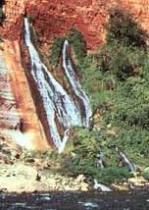 Springs can develop where either unconfined or artesian aquifers crop out at the surface. Springs develop where streams have incised so deeply that the aquifer is exposed along the valley walls where spring lines develop. A spring is groundwater becoming surface water.
Springs can develop where either unconfined or artesian aquifers crop out at the surface. Springs develop where streams have incised so deeply that the aquifer is exposed along the valley walls where spring lines develop. A spring is groundwater becoming surface water.
The photo on the right shows groundwater, discharging from springs in the Grand Canyon. Photo courtesy USGS, R.D. MacNish.
An impervious bed of shale that inhibits the downward movement of the groundwater and diverts it to the walls of a mesa can create springs, for example. The emergence of water from a series of caves in limestone may form large springs. The Columbia Plateau area of the Pacific Northwest is characterized by springs that spill from very permeable lava beds of the region.
Streams that come from the mountains in areas characterized by broad alluvial fans quickly infiltrate the alluvial fans, but the groundwater reemerges further out toward the basin. Faults are sometimes permeable enough to provide important conduits that enable water from deep sources to reach the surface.
Excellent examples of springs produced by the rise of deep water along fault zones are found along the edges of the mountain ranges of Nevada and western Utah. Oscar E. Meinzer (1923, The Occurrence of Ground Water in the U.S. with a Discussion of Principles, USGS Water-Supply Paper 489, 186) indicates that the abundance of these springs in the Basin and Range province, and the copious flow of some of them, are the more impressive because of the aridity of the region in which they occur.
The above information is excerpted in large part from Chapter 16 of the 1999 NGWA Press publication, Ground Water Hydrology for Water Well Contractors.